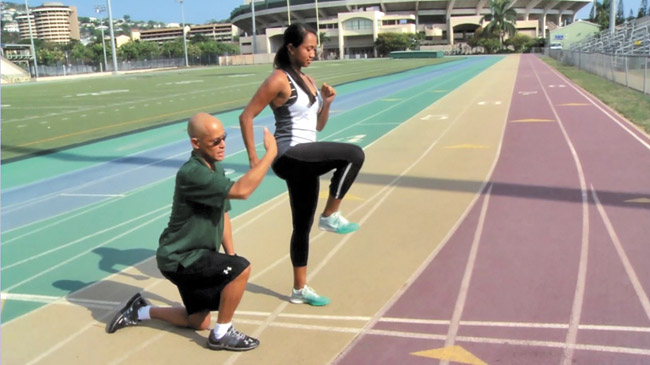The Benefits Of Dynamic Stretching

Dr. Spencer Chang works with Sam Esperanza on dynamic stretching PHOTO COURTESY HAWAII PACIFIC HEALTH
To help runners prepare for the 38th annual Hawaii Pacific Health Women’s 10K March 1, Hawaii Pacific Health will conduct a free training clinic Feb. 18 from 6 to 8:30 p.m. (registration begins at 6) at Honolulu Country Club. Health and fitness experts will present activity-based lectures covering hip preservation, running mechanics, nutrition, how to stop injuries from slowing you down and more.
You also can learn about the importance of stretching, particularly dynamic stretching versus static stretching, from Dr. Spencer Chang, a sports medicine orthopedic surgeon at Straub Clinic & Hospital and UH women’s pole vault coach.
“Dynamic stretching basically involves movement,” explains Chang. “Most sporting enthusiasts and coaches in the know would probably start with dynamic stretching first as their warm-up routine, as opposed to static stretching.
“So, if you’re warming up for the upcoming 10K, you’ll be doing movements with your legs and arms that are similar to the movements you’re going to be doing when you’re actually running.
“The idea with dynamic stretching is there’s movement and more blood flow to your muscles, and this is something you do prior to your actual exercise routine.”
An easy dynamic stretch you can do, shares Chang, is to stand next to a fence, hold on to it, and swing your leg back and forth, and then side to side. For your arms, try doing arm circles or also swing it back and forth.
“That helps to get you kind of limber,” he explains. “For your calves and legs, you also can do heel walks and toe walks, and tippy toe rises. A lot of these dynamic stretches are things we incorporate for the UH track and field team, and I think it’s also applicable for someone running in the 10K.”
As for how long your stretches should be, Chang says it varies.
“The key is to get the blood flowing into your muscles,” he explains. “You should do it enough where you can feel it loosening up and you can feel it getting some warmth into it. I would say probably at least 15 to 20 minutes. When I work with (Olympian) Bryan Clay, it’s at least an hour.”
Static stretching, which is when you’re stretching a muscle by holding a position without movement, also is important. Chang says it’s better to do these stretches after your workout.
“What we’re trying to do is maintain flexibility. The typical thing that will happen after your workout is your muscles will cool down and often it will even get tighter, so people who don’t stretch at all tend to just get tighter and tighter.
“In order to maintain the flexibility necessary to compete at a high level you should do regular static stretching. So, it’s equally important to do the dynamic stretching beforehand and your static stretching after your workout routine.”
Hawaii Pacific Health Women’s 10K takes place March 1 at 7 a.m. at Kapiolani Park, and this year, includes the first Keiki Run for children ages 5 to 10. To register, visit hawaiipacifichealth.org/womens10k.
yting@midweek.com





